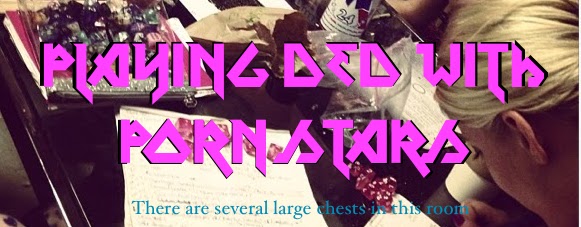-
-
 Jeff's Carousing Mishaps table. It's a classic. Tons of people use it. Jeff has many tables on his blog--why does this one work so well for so many people?
Jeff's Carousing Mishaps table. It's a classic. Tons of people use it. Jeff has many tables on his blog--why does this one work so well for so many people?Let's pull this shit apart:
-It deals with something that's already in the game but isn't usually dramatized in the game. Your PCs don't have to do some new thing or behave in a different way to use this table. It's assumed that characters are always drinking and wenching when they're not punching giant rats. It's also usually assumed that the game is about when they're punching giant rats and not about when they're drinking and wenching.
-It gives the players a toy. Let's face it: DMs have a million toys to choose from. What Color Is The Slugvomit? I have a table for that... Sometimes the game's moving at a pace where you'll use it, sometimes it isn't. This table is part of a subsystem that the players get to decide to trigger--that's slightly unusual. Give the players a wheel and generally one of them will spin it.
-It's something that comes up a lot. If you run the game like Jeff does, where each session is one delve, it can potentially come up every session. If you don't, it can still come up any time the PCs end a session in a town or city.
-The subsystem is simple. It's all over in one roll. Or two. Or maybe three. Not only are the new rules in the system simple, but unlike my plot-seed version of it, it doesn't make any demands on the game that it doesn't wrap up quickly. That hangover? That just means -2 to saves the next day--it doesn't suddenly change the whole game.
-The rules don't overlap with other rules This table doesn't have to replace or displace any other system in most other games.
-It's fun to read None of the entries stop at "functional". There's always some pithy description and some subrule or result tagged onto it. This is useful on account of:
1-Nobody's gonna decide to keep a table unless they read it, and...
2-You don't have to transfer it into game terms mentally to explain it to your players--they're written in such a way that you could just read them off the table to the group if you felt like it.
-You know why you're rolling on it Unlike this equally awesome table, the Carousing Mishaps provides color but is subtly more directed: you are rolling to see what horrible thing happened when you got drunk and how it will affect your next adventure. Story color is converted into mechanics in an interesting way. There will be a result and you, the DM, know roughly the scale of that result, so you know how much "design space" to let it have in your game--and you know it will mean something to your players.
-It doesn't make you do any work. It isn't one of those "Here's some ideas, make something up" tables. It's all right there.
-They're funny but don't force your game to be You do not necessarily have to shift over to Planet Gonzo to use these rules--partially because they compartmentalize the action into one small thing that happens at the end of a game.
_____
I'm sure there are other reasons and I'm sure I'll see them in the comments. But there you go: that's one way to write some genuinely useful rules.
Now, in the words of Jeff:
"Now somebody please go and post something twelve times cooler than my chart."
-
-
-










No comments:
Post a Comment